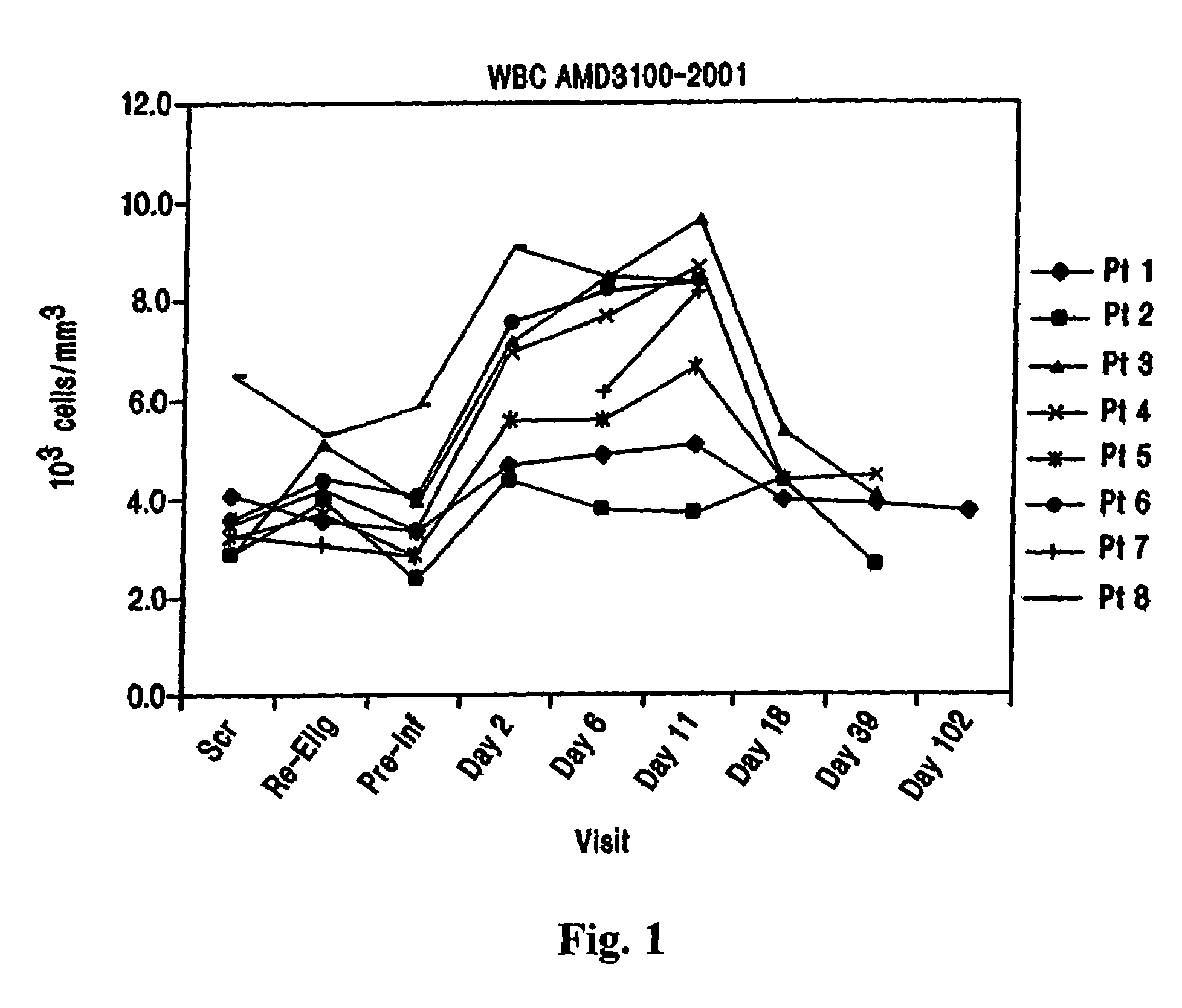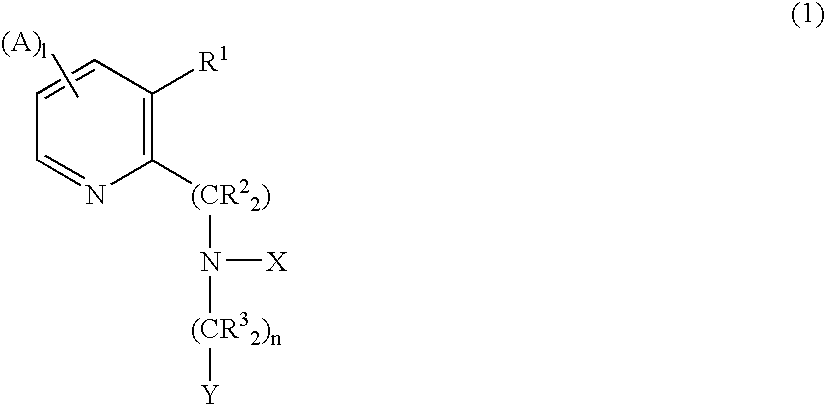CXCR4 chemokine receptor binding compounds
a chemokine receptor and binding compound technology, applied in the field of new drugs, can solve the problems of haematopoiesis and cardiogenesis, lethal deficiencies in vascular development, and inhibit the replication of hiv, and achieve the effect of destroying the effectiveness of the compound and inhibiting the replication of the virus
- Summary
- Abstract
- Description
- Claims
- Application Information
AI Technical Summary
Benefits of technology
Problems solved by technology
Method used
Image
Examples
example 1
[0138]
COMPOUND 1: N-(1H-benzimidazol-2-ylmethyl)-N-(3-methylpyridin-2-ylmethyl)-butane-1,4-diamine (HBr salt)
[0139]White solid. 1H NMR (D2O) δ 1.59 (br, 4H), 2.47 (s, 3H), 2.81 (t, 2H, J=7.4 Hz), 2.92 (t, 2H, J=7.4 Hz), 4.34 (s, 2H), 4.47 (s, 2H), 7.59 (m, 2H), 7.77 (m, 2H), 7.81 (t, 1H, J=7.0 Hz), 8.31 (d, 1H, J=7.8 Hz), 8.57 (d, 1H, J=5.7 Hz). 13C NMR (D2O) δ 17.03, 23.39, 24.94, 39.58, 50.78, 54.12, 55.26, 114.28 (2C), 125.95, 127.03 (2C), 130.93 (2C), 137.55, 138.40, 148.31, 150.42, 151.38. ES-MS m / z 324 (M+H). Anal. Calcd. for C19H25N5.3.5HBr.1.4H2O.0.4C4H10O: C, 37.40; H, 5.38; N, 10.59; Br, 42.28. Found: C, 37.46; H, 5.27; N, 10.57; Br, 42.16.
example 2
[0140]
COMPOUND 2: N1-(1H-benzoimidazol-2-ylmethyl)-N1-(3-isopropylpyridin-2-ylmethyl)-butane-1,4-diamine (HBr salt)
[0141]A 50% solution of hydrogen peroxide (24.89 mL) was slowly added to a solution of 3-isopropyl-2-methyl-pyridine (24.5 g, 183 mmol) (Ishiguro et al. Yakugaku Zasshi 1958, 78, 220) in HOAc (280 mL). The mixture was warmed to 70° C. and stirred for 18 h, then cooled to room temperature and concentrated in vacuo to remove the majority of HOAc. The mixture was basified with a saturated solution of NaHCO3 to pH 12 and extracted with CH2Cl2 (3×150 mL). The combined organic layers were dried over Na2SO4 and concentrated in vacuo to afford 3-isopropyl-2-methyl-pyridine 1-oxide (26.05 g, 94%) as a yellow oil. 1H NMR (CDCl3) δ 1.24 (d, 6H, J=7.0 Hz), 2.56 (s, 3H), 3.13 (sep, 1H, J=7.0 Hz), 7.06-7.17 (m, 2H), 8.17 (d, 1H, J=6.6 Hz).
[0142]To a stirred solution of 3-isopropyl-2-methyl-pyridine 1-oxide (26.05 g, 173 mmol) in CH2Cl2 (690 mL) was added dropwise TFAA (51.83 mL) over...
example 3
[0146]
COMPOUND 3: N1-(3-methyl-pyridin-2-ylmethyl)-N1-(1-phenyl-1H-imidazol-2-ylmethyl-butane-1,4-diamine (HBr salt)
[0147]White solid. 1H NMR (D2O) δ 1.37-1.51 (m, 4H), 2.32 (s, 3H), 2.60 (dd, 2H, J=6.9, 8.1 Hz), 2.86 (dd, 2H, J=6.9, 7.5 Hz), 4.05 (s, 2H), 4.23 (s, 2H), 7.47-7.51 (m, 2H), 7.56-7.67 (m, 5H), 7.83 (dd, 1H, J=6.0, 7.8 Hz), 8.30 (d, 1H, J=8.1 Hz), 8.46 (d, 1H, J=5.4 Hz); 13C NMR (D2O)δ 16.98; 22.92, 24.87, 39.54, 48.47, 53.59, 54.42, 119.60, 124.83, 125.98 (3 carbons), 130.75 (2 carbons), 131.51, 134.35, 137.64, 138.39, 143.99, 148.43, 150.94; ES-MS m / z 350 (m+H). Anal. Calcd. for C21H27N5.3.3HBr.2.5H2O: C, 38.13H, 5.38; N, 10.59; Br, C, 38.28; H, 5.67; N, 10.27; Br, 39.95.
PUM
| Property | Measurement | Unit |
|---|---|---|
| white blood | aaaaa | aaaaa |
Abstract
Description
Claims
Application Information
 Login to View More
Login to View More - R&D
- Intellectual Property
- Life Sciences
- Materials
- Tech Scout
- Unparalleled Data Quality
- Higher Quality Content
- 60% Fewer Hallucinations
Browse by: Latest US Patents, China's latest patents, Technical Efficacy Thesaurus, Application Domain, Technology Topic, Popular Technical Reports.
© 2025 PatSnap. All rights reserved.Legal|Privacy policy|Modern Slavery Act Transparency Statement|Sitemap|About US| Contact US: help@patsnap.com



